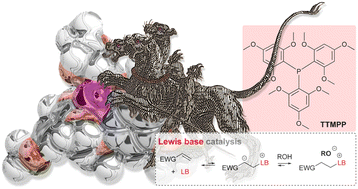Tris(2,4,6-trimethoxyphenyl)phosphine – a Lewis base able to compete with phosphazene bases in catalysing oxa-Michael reactions†
Abstract
The performance of the strong Lewis base tris(2,4,6-trimethoxyphenyl)phosphine (TTMPP) in catalysing oxa-Michael reactions is assessed and compared with other electron-rich tertiary arylphosphines and, as the benchmark, with the Brønsted base 1-tert-butyl-2,2,4,4,4-pentakis-(dimethylamino)-2λ5,4λ5-catenadi-(phosphazen) (P2-tBu). A matrix of five varyingly strong Michael acceptors and four varyingly acidic alcohols is used to evaluate the activity of the catalysts. The study demonstrated that TTMPP shows a significant superiority over other arylphosphine based Lewis bases and a similar activity to P2-tBu under highly concentrated, quasi solvent free conditions. Furthermore, the performance of TTMPP and P2-tBu is compared in the oxa-Michael polymerisation reactions of 2-hydroxyethyl acrylate (HEA) and of 1,4-butanediol diacrylate (BDDA) with diols under solvent free conditions. In the case of HEA, TTMPP is preferred over P2-tBu because the latter gave a not fully soluble polymeric product. TTMPP is the first Lewis base capable of catalysing the oxa-Michael polymerisation of diacrylates and diols, albeit P2-tBu catalysis results in higher molar masses in this polymerisation reaction. Furthermore, the performance of the catalysts under diluted conditions was assessed and the activity of TTMPP is distinctly more concentration dependent than the activity of P2-tBu. The use of the polar protic solvent t-butanol mitigates the negative impact of dilution exerted by nonpolar aprotic and polar aprotic solvents such as toluene or dimethylformamide. Finally, data are shown confirming TTMPP to have limited but still acceptable stability to oxygen for practical work in air.



 Please wait while we load your content...
Please wait while we load your content...